What is Web Analytics?
Web analytics is the process of tracking, collecting, and analyzing data from websites and apps. It shows how people use your digital platforms. By examining this data, you can identify patterns in user behavior, engagement, and conversion.
With web analytics, you can find out which pages visitors like, how long they stay, and what actions they take. This provides a clear picture of the user journey, helping you improve your website.
What is Web Analytics Used For?
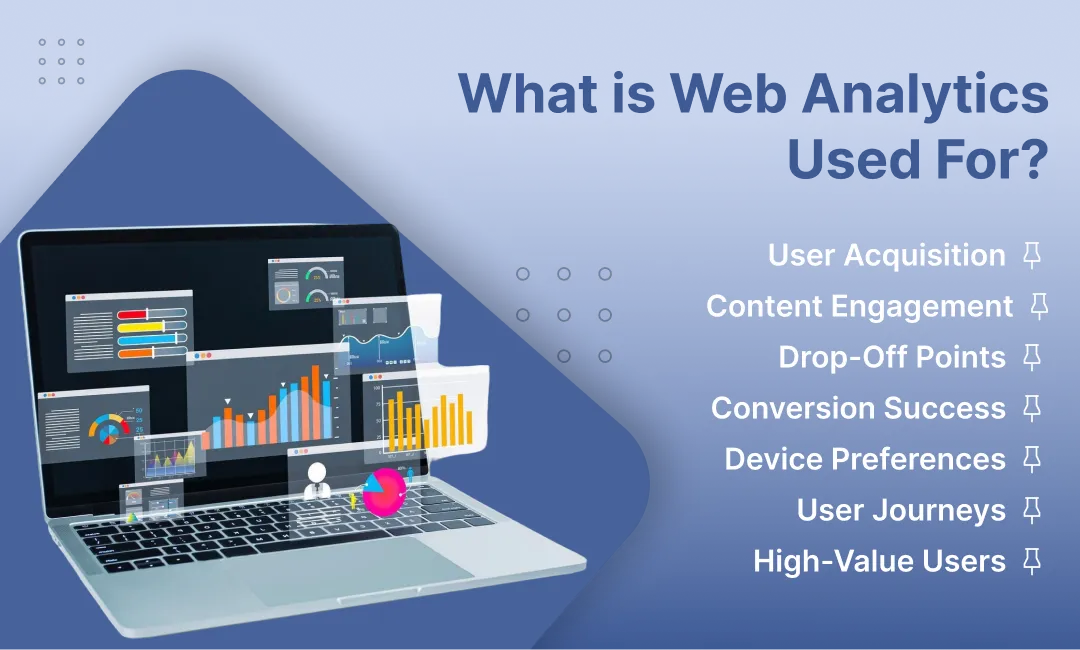
It lets you track the sources that bring people to your website. It also shows which site content is popular. You can track the average stay and see how users interact with your pages. You can also find pages where visitors leave. Tools like Amplitude’s Journeys provide valuable insights into user behavior by showing exactly how users navigate through your site.
Using this data, you can improve underperforming pages, enhance audience engagement, and optimize your website for a more seamless user experience.
Web analytics gives a clear view of user behavior on your site or app. It shows how visitors interact, which pages they visit, and how they engage with your features. This data helps you understand users, grow conversions, and improve your website’s performance
Here’s what web analytics can tell you:
● User Acquisition: Identify which channels—like search or social—bring in the most traffic. Use these insights to enhance your digital marketing and SEO strategies.
● Content Engagement: Identify which pages or features capture the most attention. Focus on high-performing content to boost user engagement and keep visitors longer.
● Drop-Off Points: A drop-off point is where visitors leave your website. These points highlight areas needing usability fixes or content improvements.
● Conversion Success: Measure the performance of your call-to-action buttons. Web analytics shows where visitors come from, helping you improve conversions and guide users along effective journeys.
● Device Preferences: Learn which devices visitors prefer. Optimize for mobile and ensure cross-platform usability.
● User Journeys: Track paths from landing pages to conversion. Straightforward navigation guides users smoothly, enhancing both conversions and the overall user experience.
● High-Value Users: Identify loyal users or highly engaged users. Use this data to create targeted retention strategies and maximize value.
Applying these insights in your digital marketing and SEO plans ensures you reach the right audience. Understanding user behavior, engagement, and conversion patterns makes your campaigns more effective and your website delivers measurable results.
Categories of Web Analytics
The data you collect about your company’s online performance comes from many sources. Web analytics falls into two types: on-site and off-site, depending on the data source.
1. On-Site Web Analytics
On-site web analytics help you understand visitor behavior and interactions on your site.They help you track how users engage and convert. Tools like Amplitude provide self-serve analytics, making it easy to see what happens on your site.
The most common method is page tagging. When a page is tagged with a snippet of code, it collects data from each visitor. This allows visitor tracking and shows their path to bounce or conversion. With real-time data, you see which parts of your site work well and which lose readers before they convert. This improves site effectiveness and overall user experience.
2. Off-Site Web Analytics
With off-site web analytics, third-party data shows how your site performs in the bigger market. They show how your website compares to those of your competitors.
For example, a social media analytics tool can show how your brand’s voice compares to two main competitors. Your on-site analytics might show steady visitors from Instagram or TikTok, highlighting your social reach.
Off-site data could also show your brand appears in 10% of discussions while a competitor appears in 50%. This reveals your potential audience and identifies areas for improvement in digital marketing and SEO efforts.
The Importance of Web Analytics
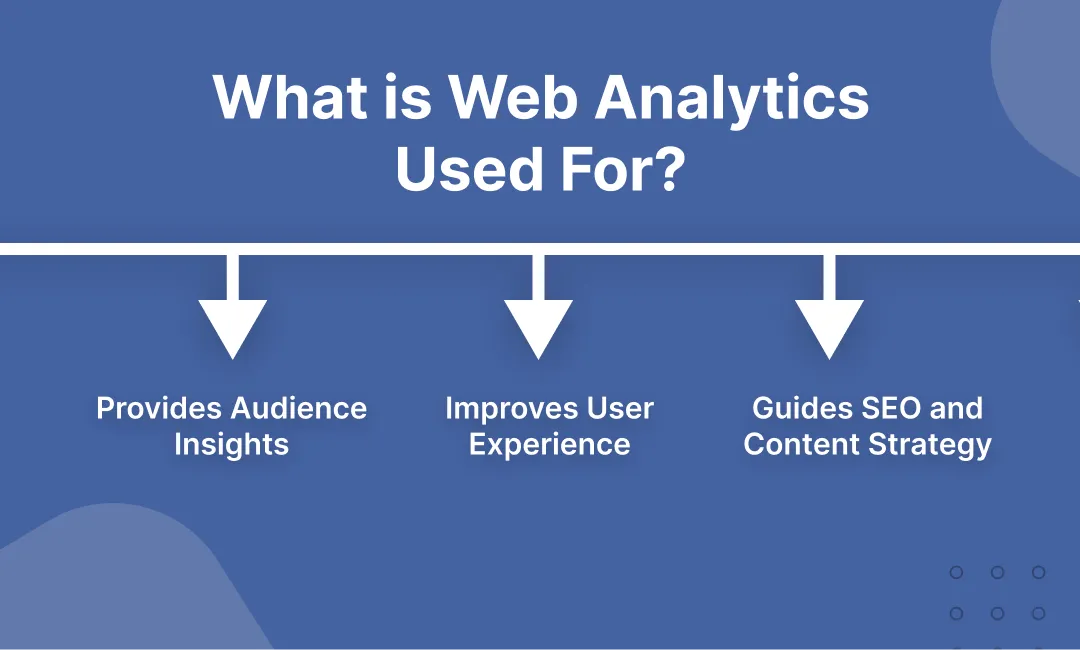
1. Provides Audience Insights
Web analytics is the best tool which provides clear insight of your site visitors. One key metric is traffic source. It shows which channels bring users to your website and their corresponding geographic locations.
For example, you may assume your audience is on the West Coast based on LinkedIn, but analytics may reveal that most visitors are mobile searchers in the Northeast. It allows you to target your digital marketing campaigns more effectively.
2. Improves User Experience
Web analytics also helps improve user experience. Understanding site visitors allows you to make smart adjustments.
If the majority of your audience is on mobile, put mobile-friendly design at the top of your list. If a page gets high traffic, optimize it for the content visitors need. You can also adjust page navigation to make it easier to find meaningful content. These changes keep users engaged and guide them smoothly along the conversion path.
3. Guides SEO and Content Strategy
Web analytics helps align your SEO goals with content strategy. Examining top-viewed posts reveals which content topics are most effective.
If how-to tutorials like WordPress tutorials dominate your top posts, focus more on this type of content. Analytics also show which channels drive traffic. If organic traffic and email traffic perform better than paid channels, allocate resources to strengthen SEO and organic marketing efforts.
Now that we understand what web analytics is and why it matters, let’s examine the key metrics that help drive traffic, leads, and revenue growth.
What Are Key Metrics to Measure in Web Analytics?

Tracking the right key metrics is essential to measure how well your website performs. They explain how visitors move and interact across your site. They also help improve user engagement, digital marketing, and SEO strategies.
Let’s break down the most critical metrics.
1. Page Visits and Sessions
● Page visits and sessions measure the traffic to a webpage over a specific period. More visits indicate your site is being noticed.
● A session covers the user’s full visit, including multiple pages from entry to exit.
● Example: 200 visits per month may seem minor. However, if these are high-intent views—from prospects actively considering a purchase—this post is extremely valuable for your digital marketing and SEO efforts.
2. Unique Pageviews
● Unique pageviews count provides the facility of number of each visitor, visit once per session, unlike pageviews that count every page load.
● Example: A visitor lands on a product page, visits the knowledge base, and returns. This counts as two page visits, but only one unique page view.
● Tracking unique pageviews helps estimate your audience size, measure page popularity, and optimize content for SEO.
● It avoids skewed data from users reloading or revisiting pages, giving you clearer SEO and digital marketing insights
3. Traffic Source
● These tools show how visitors find you—through social media, search engines, or email. Knowing these traffic sources helps you fine-tune your marketing strategy and improve SEO performance
● Example: If clicks from email campaigns drive traffic, sending more targeted emails can increase engagement, conversions, and digital marketing ROI.
4. Conversion Rate
● The conversion rate shows the percentage of users who complete a key goal on your site.
● A conversion happens when someone takes a key action, like buying a product or signing up with their email
● Track multiple conversion events to understand deep engagement and optimize both digital marketing campaigns and SEO funnels.
5. Bounce Rate
● High bounce rates can be negative or positive. It may indicate low user engagement or that users found all the information they needed.
● Combining bounce rate with time on page helps determine if pages need improvements for SEO and digital marketing effectiveness.
6. Repeat Visit Rate (Returning Visitors)
● Measures how often users return to your site.
● Shows your core audience—people who regularly engage with content.
● Example: A 30% repeat visit rate is strong. A score below 20% may indicate that your site needs more engaging content to improve its digital marketing and SEO performance.
7. Monthly Unique Visitors (New Visitors)
● Counts first-time visitors each month.
● Shows how well your site attracts new audiences.
● A healthy website maintains steady new visitors, boosting growth, user engagement, and digital marketing results.
8. Unique Ecommerce Metrics
● For ecommerce, additional KPIs help improve sales and guide digital marketing and SEO strategies.
● Shopping cart abandonment rate: Tracks users who leave without completing a purchase—lower abandonment rates result in higher revenue.
● Average order value & products per sale: Optimizing these increases sales and website effectiveness, benefiting both digital marketing and SEO campaigns.
Best Practices for Using Web Analytics Effectively
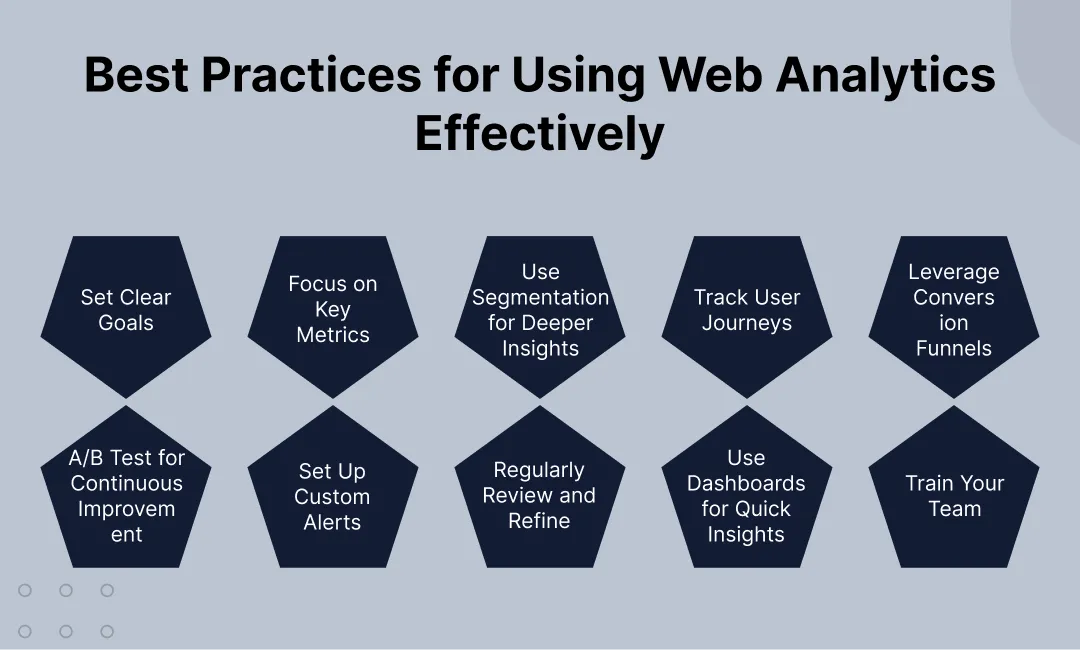
Web analytics can transform your business. It helps you understand your audience, boost engagement, and increase conversions. To achieve real value, you need a clear strategy that aligns with your digital marketing and SEO goals.
1. Set Clear Goals
Before exploring data, define clear, measurable goals. Do you want more leads, higher engagement, or more sales? Your goals determine which metrics matter. They prevent data overload and keep your focus on actionable insights for your digital marketing campaigns.
2. Focus on Key Metrics
Web analytics tools track hundreds of metrics, but only a select few are truly important. Begin with core key metrics, such as traffic sources, bounce rate, and conversion rate. These metrics give you a starting point. Refine them as you learn what drives SEO results and your digital marketing goals.
3. Use Segmentation for Deeper Insights
Break your data into segments to discover patterns. Divide users by demographics, traffic source, device, or behavior. For example, check if mobile users engage differently from desktop users. Segmentation uncovers hidden trends and helps tailor strategies for each group, boosting user engagement.
4. Track User Journeys
Follow how users move through your site by tracking user journeys. See where they start, which pages they visit, and where they drop off. These insights reveal areas where friction points exist and opportunities for improvement. When users enjoy your site, they stay longer—and your SEO gets better too.
5. Leverage Conversion Funnels
It shows how visitors move through stages before completing an action. Track each step to identify where users drop off. If many drop off, investigate why. It could be confusing content, long forms, or slow load times. Optimizing funnels improves conversions and supports your digital marketing campaigns.
6. A/B Test for Continuous Improvement
A/B testing helps you see which page version performs better, whether it’s the headline, design, or button. Small changes, such as button colors or wording, can significantly improve conversions. Testing keeps your SEO and digital marketing strategies effective and user-focused.
7. Set Up Custom Alerts
Analytics tools allow you to set custom alerts when traffic rises or conversions fall. Alerts keep you proactive, notifying you immediately if action is needed. This protects website performance and keeps digital marketing efforts on track.
8. Regularly Review and Refine
Web analytics works best when reviewed on a regular basis. Track results and adjust your SEO strategy. Routine checks and refinements maintain metrics, improve SEO, and keep user engagement high.
9. Use Dashboards for Quick Insights
Create custom dashboards with your key metrics. You get an instant view of how things are performing. Dashboards save time and enable data-driven decision-making. They also make it easier to share insights with your team, improving digital marketing outcomes.
10. Train Your Team
Analytics are strongest when your team understands them. Train them on key metrics, reporting, and data interpretation. When everyone can access data, your team makes informed, aligned decisions. You’ll see stronger SEO, better digital marketing results, and smoother site performance.
What Are the Top Web Analytics Tools?
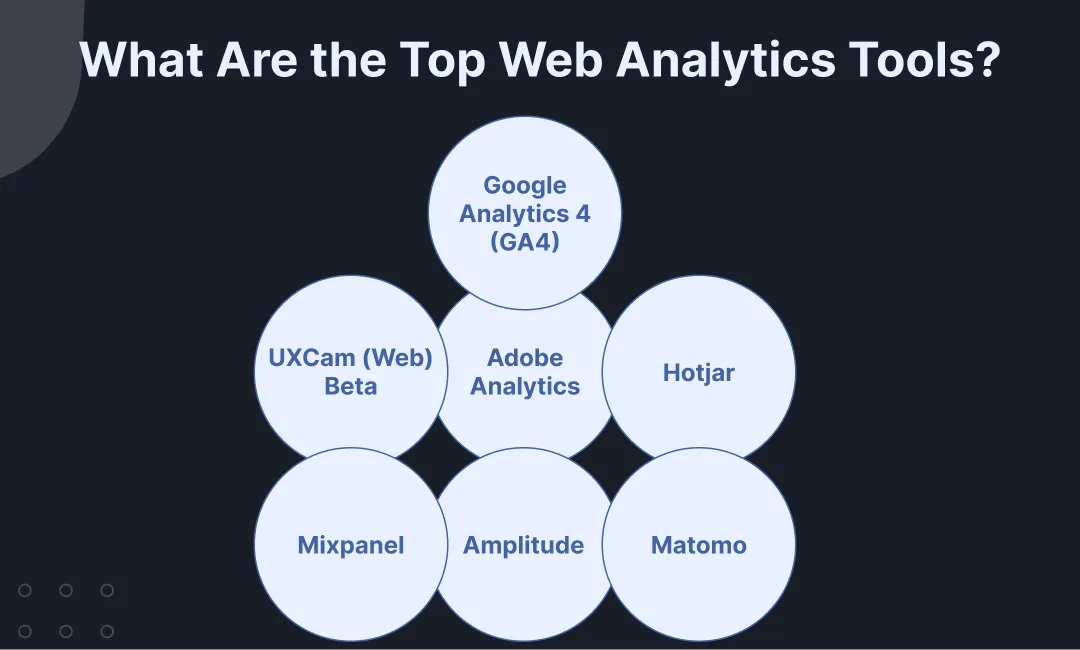
Choosing the right web analytics tool can feel overwhelming.There are many tools, each with its own unique features. From user behavior tracking to conversion optimization, every tool serves a specific need. We’ve put together a simple guide to leading web analytics tools and their features:
1. Google Analytics 4 (GA4)
It is a free tool used by most businesses to track websites and apps. It comes with AI-driven insights and works well with other Google products. GA4 helps track traffic, user journeys, and conversions while supporting SEO and digital marketing campaigns.
● Free analytics for web and apps
● AI insights with Google integration
● Track traffic, conversions, and user journeys
● Supports SEO and digital marketing strategies
2. UXCam (Web) Beta
It helps to improve user experience with session replays, heatmaps, and conversion tracking for both web and mobile apps. It’s ideal for teams working on UX optimization. By studying user behavior, businesses can enhance engagement, optimize SEO-focused interactions, and improve overall digital marketing results.
● Session replays and heatmaps
● Conversion tracking for apps and web
● Boost engagement and user experience
● Improve SEO-focused interactions
3. Adobe Analytics
It is a powerful tool for large enterprises. It offers real-time reports, predictive analytics, detailed segmentation, and seamless integration with Adobe products. It provides advanced insights into engagement and conversions, helping businesses refine their digital marketing strategies and enhance SEO across all channels.
● Real-time and predictive analytics
● Advanced segmentation
● Strong Adobe product integration
● Optimizes digital marketing and SEO
4. Hotjar
Hotjar combines heatmaps, recordings, and feedback tools to make websites more user-friendly. It’s ideal for businesses seeking to increase conversions. Hotjar helps identify problem areas, optimize calls-to-action, and improve both SEO rankings and digital marketing performance.
● Heatmaps and session recordings
● Conversion funnel tracking
● Collects user feedback easily
● Enhances SEO and digital marketing
5. Mixpanel
focuses on user behavior tracking, event analytics, funnels, and cohorts.Perfect for SaaS and mobile apps aiming to keep users more engaged. Businesses can track user interactions, increase retention, and run stronger digital marketing campaigns while driving organic SEO growth.
● Event analytics and funnels
● User behavior tracking
● SaaS and mobile app focus
● Boosts retention, SEO, and marketing
6. Amplitude
It helps track product performance, segment users, and understand their journey.A great fit for product teams aiming to understand growth better. Amplitude helps optimize engagement, improve conversion funnels, and refine both SEO and digital marketing strategies using behavioral data.
● Product analytics and growth insights
● Journey mapping and segmentation
● Optimize engagement and funnels
● Improves SEO and digital marketing
7. Matomo
This is an open-source, self-hosted analytics tool that ensures complete data control and GDPR compliance.Best suited for companies that care about protecting privacy and keeping data secure. Matomo tracks traffic sources, conversions, and user behavior, supporting SEO and digital marketing without relying on third-party platforms.
● Open-source and self-hosted
● Complete data privacy and GDPR compliant
● Track traffic, conversions, and engagement
● Supports SEO and digital marketing control
Common Issues with Web Analytics
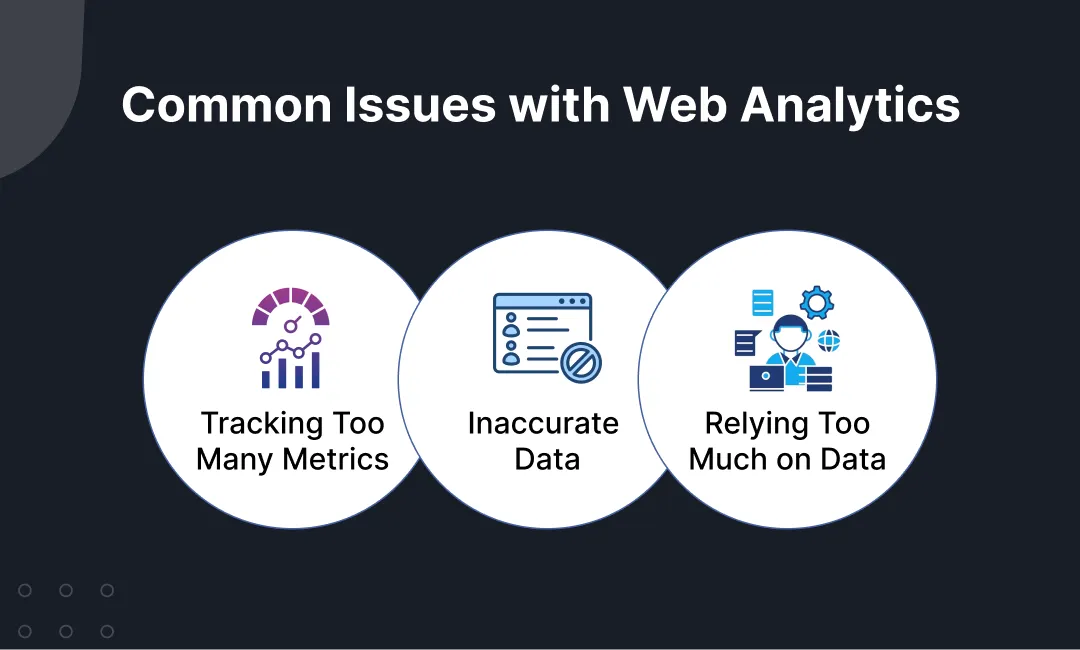
Web analytics is a powerful tool. It helps improve website experience, track user behavior, and guide digital marketing and SEO strategies. However, relying solely on numbers can lead to mistakes. Here are the main common issues with web analytics.
1. Tracking Too Many Metrics
It’s tempting to track every metric. Many businesses make this mistake. Focus on a few key metrics that actually drive results in digital marketing and SEO. This keeps your analytics setup clean and actionable. Ignore distractions that dilute insights.
2. Inaccurate Data
Most web analytics data is accurate. But some data can be misleading.
Spam traffic from bots or false sources is a common problem. Blockers help, but sometimes it’s better to ignore suspicious data.
With the shift to a cookieless internet and an increasing number of users opting out of tracking, some statistics may not accurately reflect reality. Focus on overall trends and actions you can take, rather than isolated stats
3. Relying Too Much on Data
Web analytics shows only part of the picture. It cannot capture complete website visibility, website performance, or all business goals.
Overreliance can lead to poor decisions. Treat data as guidance for product management, UX, marketing, digital marketing, and SEO. Use web analytics tools to inform decisions, not dictate them.
Conclusion
Web analytics helps you understand user behavior, improve UX, and guide strategic decisions in digital marketing and SEO. Track key metrics, utilize the right tools, and adhere to best practices to transform data into actionable insights.
It’s more than numbers. Web analytics aligns data with business goals, improves digital marketing campaigns, and drives measurable SEO results. Regular checks, goal updates, and contextual interpretation ensure your decisions are informed, innovative, and effective.
Select a web analytics tool that aligns with your workflow. Review your setup and apply best practices to ensure optimal performance. Doing this unlocks growth opportunities and provides your analytics workflow delivers real impact.







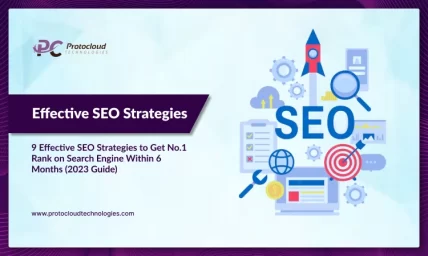
Leave a Reply